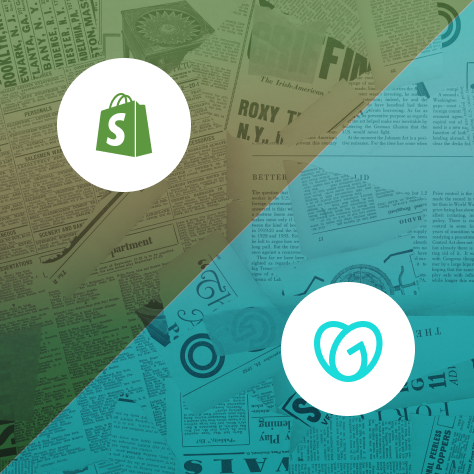Shopify Vs BigCommerce: Which Platform Maximizes Profitability In 2025?
Choosing an ecommerce platform is one of the most important decisions for any online business. In 2025, many merchants are comparing Shopify and BigCommerce to understand which solution better supports long-term profitability.
Both platforms serve online stores of all sizes, from early-stage brands to large enterprises. They offer similar core functionalities—such as product catalogs, checkout systems, and integrations—but their philosophies and infrastructures differ in key ways.
This article breaks down the differences between Shopify and BigCommerce. It focuses on the features that impact profitability, from pricing models to customization tools, ease of use, and enterprise support.
What Makes Shopify Or BigCommerce Unique?
Shopify and BigCommerce are both cloud-based ecommerce platforms that let merchants build online stores without managing servers or infrastructure. While they seem similar at first glance, they follow different approaches to ecommerce.
Shopify focuses on simplicity. It offers an intuitive interface that helps non-technical users launch stores quickly. The platform includes essential features out-of-the-box and provides access to thousands of apps for added functionality.
BigCommerce emphasizes built-in capabilities. It includes more native features for complex catalogs and B2B selling without requiring additional apps. This approach appeals to merchants who want more control over their store's technical setup.
In terms of market presence, Shopify powers more than 20% of online stores globally, while BigCommerce serves a smaller segment focused on mid-market and enterprise businesses. This difference reflects their core strengths: Shopify's ease of use versus BigCommerce's technical flexibility. Additionally, Shopify's revenue reached $2 billion in Q2 2024, representing a 21% year-over-year growth, while processing 199 million orders per month in 2023.
In terms of market presence, Shopify powers more than 20% of online stores globally, while BigCommerce serves a smaller segment focused on mid-market and enterprise businesses. Shopify dominates global e-commerce with 10.32% market share (ranking 4th worldwide) and powers 4.6 million websites, while BigCommerce holds just 3.2% global market share with 41,271 active stores. This difference reflects their core strengths: Shopify's ease of use versus BigCommerce's technical flexibility.
- Platform philosophy: Shopify prioritizes user experience and quick setup; BigCommerce focuses on built-in functionality and developer access
- Best fit: Shopify works well for brands seeking a no-code approach; BigCommerce suits businesses needing advanced native features
- Market position: Shopify dominates the market share; BigCommerce targets businesses with complex requirements
Comparing Pricing And Total Cost For Shopify Vs BigCommerce
When comparing bigcommerce vs shopify pricing, looking beyond monthly subscription fees reveals the true cost of running an online store. Both platforms offer similar pricing tiers, starting around $29-39 per month for basic plans and increasing to $299-399 for advanced features.
The app ecosystem also affects total costs. Shopify's approach relies more on apps for extended functionality, which can add $50-300 monthly to operating expenses. However, Shopify delivers 31% better total cost of ownership than BigCommerce, with 88% lower implementation costs, 32% lower app expenses, and 21% reduced operational costs. BigCommerce includes more features natively, potentially reducing the need for paid add-ons.
The app ecosystem also affects total costs. Shopify's approach relies more on apps for extended functionality, which can add $50-300 monthly to operating expenses. BigCommerce includes more features natively, potentially reducing the need for paid add-ons.
For enterprise solutions, both platforms offer custom pricing. Shopify Plus typically starts around $2,000 monthly, while BigCommerce Enterprise pricing varies based on sales volume and feature requirements. When evaluating the best pricing options between shopify plus or bigcommerce, consider both the base subscription and additional costs for apps, development, and transaction fees.
Long-term costs also depend on development needs. Shopify's streamlined approach may reduce ongoing maintenance expenses, while BigCommerce's flexibility might require more technical resources but fewer app subscriptions.
Ease Of Use: Which Platform Is Simpler For Your Team?
The dashboard experience differs significantly between these platforms. In the big commerce vs shopify comparison, Shopify offers a cleaner, more intuitive interface with a gentle learning curve. Its admin panel organizes features logically, with a left-side navigation menu that provides access to products, orders, customers, and analytics.
BigCommerce presents more options upfront. Its dashboard includes advanced settings visible from the start, which provides more control but can overwhelm new users. The interface organizes features into categories with expandable submenus that reveal additional options.
Adding products illustrates this difference clearly. Shopify walks merchants through a step-by-step process with clearly labeled fields for essential information. BigCommerce displays more fields on a single screen, including advanced options for inventory management and product variations.
Content management follows similar patterns. Shopify's content editor uses a visual approach that shows how changes will appear on the live site. BigCommerce offers more detailed control but requires more clicks to preview changes.
- Dashboard clarity: Shopify uses a minimalist design with progressive disclosure of options; BigCommerce shows more technical options upfront
- Learning investment: Shopify typically takes hours to learn; BigCommerce may take days to explore fully
- Day-to-day tasks: Both platforms handle routine operations effectively, but Shopify streamlines common workflows
Design And Customization: How Flexible Are These Platforms?
Both Shopify and BigCommerce offer theme marketplaces with professionally designed templates. Shopify provides about 10 free themes and over 100 premium options ($180-380). BigCommerce offers similar numbers with premium themes ranging from $150-300.
The customization process differs between platforms. Shopify's theme editor uses a visual interface where merchants can drag sections, change colors, and update content without coding. More advanced changes require knowledge of Liquid, Shopify's templating language.
BigCommerce uses a similar visual editor but with some limitations depending on the theme. Its Stencil framework gives developers access to theme files for custom modifications. This approach offers flexibility but may require more technical knowledge for significant changes.
When comparing shopify vs big commerce for design flexibility, both platforms allow extensive customization. The key difference lies in the approach: Shopify emphasizes visual editing with developer options available when needed, while BigCommerce provides more direct access to theme code.
For merchants without technical teams, Shopify's approach may prove more accessible. For those with development resources, BigCommerce offers comparable flexibility with different tools.
Key Features That Drive Revenue Growth
The checkout experience directly impacts conversion rates. Shopify provides a streamlined, optimized checkout process that works across devices. Its Shop Pay feature saves customer information for faster future purchases, potentially increasing conversion rates by 12% compared to standard checkouts.
BigCommerce allows more customization of the checkout process but requires developer assistance for significant changes. It relies on third-party payment processors without a proprietary accelerated checkout option like Shop Pay.
Marketing tools also differ between platforms. In a shopify versus bigcommerce comparison of built-in features:
- Shopify includes: Basic discount codes, abandoned cart recovery on all plans, email marketing integration, and social selling channels
- BigCommerce includes: Advanced discount rules, customer groups for targeted promotions, and abandoned cart recovery on higher plans
Both platforms support SEO with customizable URLs, meta descriptions, and structured data. BigCommerce offers slightly more built-in SEO tools, while Shopify provides similar capabilities through its ecosystem.
The shopify bigcommerce comparison for marketing reveals a pattern: Shopify provides essential features with an app marketplace for extensions, while BigCommerce builds more functionality into the core platform.
Advanced Capabilities For Growing Businesses
Shopify implements headless commerce through its Storefront API and Hydrogen framework. This approach provides a structured path for developers building custom experiences. Additionally, Shopify's Shop Pay checkout converts 50% better than guest checkouts and outperforms other accelerated checkout options by at least 10%, significantly boosting merchant profitability. BigCommerce uses its API-first architecture to support headless implementations with various front-end technologies.
Shopify implements headless commerce through its Storefront API and Hydrogen framework. This approach provides a structured path for developers building custom experiences. BigCommerce uses its API-first architecture to support headless implementations with various front-end technologies.
For businesses operating in multiple regions or with separate brands, multi-store management becomes important. BigCommerce offers native multi-storefront capabilities from a single dashboard. Shopify requires separate store instances with individual management, though Shopify Markets helps coordinate international selling.
Enterprise features show significant differences. Shopify Plus includes automation tools like Flow and Launchpad that help large businesses manage complex operations. BigCommerce Enterprise focuses on B2B capabilities, including customer-specific pricing, quote management, and company accounts.
When comparing shopify plus vs bigcommerce for enterprise needs, consider your business model:
- Shopify Plus excels at: Automation, high-volume consumer sales, and rapid scaling
- BigCommerce Enterprise specializes in: B2B selling, complex catalog management, and multi-storefront operations
Support And Ecosystem: Real-World Help When You Need It
Both platforms offer 24/7 support through chat, email, and phone. Response times vary by plan level, with premium tiers receiving priority service. The quality of support depends partly on the complexity of the issue, with technical questions sometimes requiring escalation.
Developer resources differ significantly. Shopify maintains extensive documentation and a large community of developers. Its app marketplace includes over 10,000 extensions, from free tools to comprehensive solutions. BigCommerce has a smaller but focused developer community with documentation for its API and Stencil framework.
When merchants compare shopify and bigcommerce ecosystems, they find Shopify's partner network includes thousands of experts across design, development, and marketing. BigCommerce has fewer certified partners but specializes in technical implementation and enterprise projects.
The choice between ecosystems often depends on your business needs:
- Shopify's ecosystem benefits: Wide variety of apps, many implementation partners, active community forums
- BigCommerce's ecosystem strengths: More specialized partners for complex projects, fewer but more comprehensive apps
Which Platform Maximizes Profitability In 2025?
The platform that maximizes profitability depends on your business model, technical resources, and growth plans. Shopify typically offers lower total costs for small to medium businesses due to its efficient implementation and streamlined operations. BigCommerce may prove more cost-effective for complex B2B operations or multi-brand businesses that benefit from its native features.
For most consumer brands, Shopify's combination of ease of use, optimized checkout, and extensive app ecosystem supports profitability through higher conversion rates and lower operational costs. Its infrastructure handles high-volume sales periods without additional investment, and its interface reduces training time for staff.
BigCommerce offers advantages for businesses with specific needs. Its lack of transaction fees benefits high-volume merchants using third-party payment processors. Its built-in B2B features save on app costs for wholesale operations. Its multi-storefront capabilities simplify management for brands with multiple sites.
When considering shopify vs woocommerce vs bigcommerce, remember that WooCommerce requires self-hosting and more technical management. While it offers high flexibility and potentially lower software costs, it adds infrastructure responsibilities that impact total ownership costs.
The right choice comes down to alignment with your business model:
- Direct-to-consumer brands: Shopify typically offers better conversion rates and simpler operations
- B2B and wholesale: BigCommerce includes more native B2B features
- Multi-brand operations: BigCommerce provides better tools for managing multiple storefronts
- Technical resources: Limited technical teams often find Shopify easier to manage
Making Your Platform Decision
The platform that best supports your profitability goals depends on your specific business needs. Consider these factors when making your decision:
- Current size and growth plans: Both platforms scale, but in different ways
- Technical resources: Consider your team's capabilities and available development support
- Business model: B2C, B2B, or hybrid approaches benefit from different features
- Total cost calculation: Include subscription fees, app costs, payment processing, and operational expenses
For merchants already using Shopify, migrating to BigCommerce requires weighing potential benefits against transition costs. The shopify to bigcommerce migration process involves exporting data, rebuilding the storefront design, and reconfiguring integrations. This process typically takes several weeks and requires technical assistance.
Many Shopify merchants find they can achieve their profitability goals by optimizing their existing stores rather than migrating platforms. Tools that improve conversion rates, streamline operations, or enhance customer experience often provide better returns than platform changes.
Platter helps Shopify merchants maximize profitability through conversion optimization and storefront improvements without complex development. By focusing on the performance aspects that directly impact revenue, merchants can achieve better results from their existing Shopify investment.
Looking to maximize your Shopify store's profitability without complex development? Book a demo to explore how Platter can optimize your Shopify storefront with no-code solutions that boost conversion rates and average order value.
FAQs About Shopify Vs BigCommerce
How do I migrate from Shopify to BigCommerce?
Migrating involves exporting your products, customers, and orders from Shopify and importing them into BigCommerce using its built-in tools or third-party migration services that can help with data transfer and theme setup.
Which platform offers better SEO capabilities?
Both platforms support essential SEO features including customizable URLs and metadata, with BigCommerce offering slightly more built-in SEO tools while Shopify provides comparable functionality through its theme settings and app ecosystem.
Can I use Shop Pay on BigCommerce?
No, Shop Pay is Shopify's proprietary checkout solution and is not available on BigCommerce, which instead supports standard payment gateways like PayPal, Stripe, and Authorize.net.
Which platform is better for international selling?
Shopify supports international selling through Shopify Markets with currency conversion and language options, while BigCommerce offers multi-currency and multi-language support with better multi-storefront management from a single dashboard.
How do app ecosystems compare between Shopify and BigCommerce?
Shopify offers a larger app ecosystem with over 10,000 apps covering virtually every business need, while BigCommerce has fewer apps (around 1,300) but includes more functionality in its core platform.






-min.webp)




.webp)



















.svg)


.svg)











.png)

%201.png)



.svg)
.svg)
